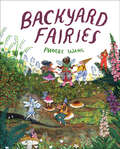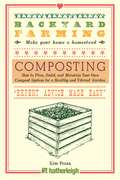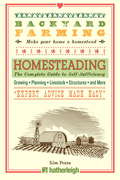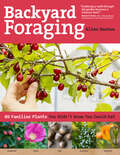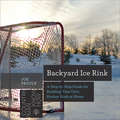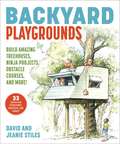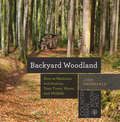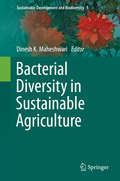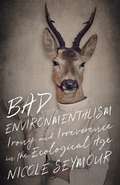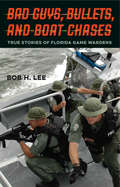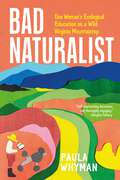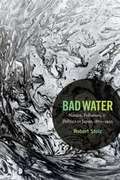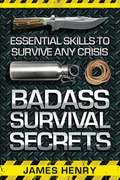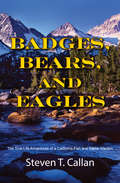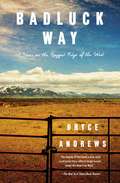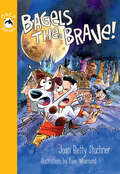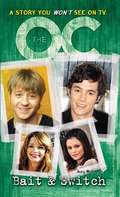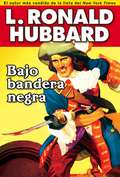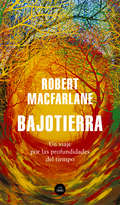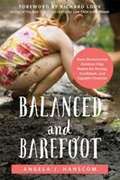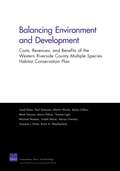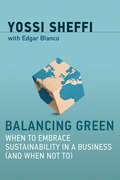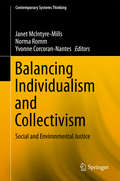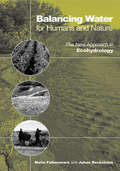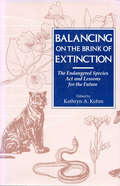- Table View
- List View
Backyard Fairies
by Phoebe WahlFrom an Ezra Jack Keats Award-winning illustrator comes a magical story that proves fairies are real and they're all around us.They MUST be. Who else could have braided the dog's hair? Who else could be playing that faint music in the air? And who else could've made those mysterious circles in the grass? So thinks a little girl as she sets out into the woods in her backyard searching for the elusive little creatures. Although readers can see them, as hard as she looks, the fairies are always just out of view for our heroine. In the end, it's clear (to the girl AND to readers) that there is magic all around, even when it's hidden in plain sight. Lush, multi-textured illustrations bring the woods (and the fairies) to life in this playful read-aloud by Phoebe Wahl. Kids will delight in seeing the fairies hidden in each piece of art and revel in the tricks and games the fairies play on our unsuspecting heroine.
Backyard Farming: How to Plan, Build, and Maintain Your Own Compost System for a Healthy and Vibrant Garden (Backyard Farming #11)
by Kim PezzaYour Backyard Farming Experience Begins Here!Give Back to Your Garden by Composting!Backyard Farming: Composting is your all-in-one guide for creating your own homestead composting plan and adding rich, nourishing humus to your garden. This guide reviews every important topic from what should and should not be composted, benefits and uses for compost, how to build a compost bin, and much more.Whether you’re composting the waste from your farm or just the scraps from your kitchen, Composting is the comprehensive primer for anyone looking to start composting and bring that “black gold” to their own garden. Including detailed instructions and informative photographs that help ensure your compost system is practical and productive, Composting takes you step by step through everything you need to nourish your garden—and build healthy, rich soil.With Composting, you will:• Choose the composting method that works best for you, your needs, and your available material• Discover how to begin a compost system and how to maintain it for optimal yield• Construct your own composting system from a variety of easy-to-follow plans• Learn how to troubleshoot any problem your compost pile might develop• Find out how best to use your compost—including indoor container gardening...and much more to help you achieve success.More than ever, people everywhere are making a return to a self-sufficient, sustainable lifestyle. Join the growing movement of homemakers looking to a healthier, happier way of life—and it starts right in your very own backyard.Backyard Farming is a series of easy-to-use guides to help urban, suburban, and rural dwellers turn their homes into homesteads. Whether planning to grow food for the family or for sale at the local farmers market, Backyard Farming provides simple instruction and essential information in a convenient reference.
Backyard Farming: The Complete Guide to Self-Sufficiency
by Kim PezzaYour Backyard Farming Experience Begins Here!Join the Backyard Farming Movement and Turn Your Home into a Homestead!Backyard Farming: Homesteading is your all-in-one guide to successfully turning your rural property, suburban home, or urban dwelling into a productive food oasis. Covering every topic from finding and developing the perfect property, as well as which produce and livestock combinations are easiest to start with, Homesteading takes the anxiety and guesswork out of enjoying the backyard farming revolution.Whether you have 100 acres of open land or just a small backyard or apartment terrace, Homesteading is the comprehensive primer for anyone looking to grow their own food. Including detailed instructions and informative photographs that help ensure your backyard farm is everything you want it to be, Homesteading walks you step by step through the process of planning and implementing your sustainable lifestyle.With Homesteading, you will:* Learn what to look for when considering properties for backyard farming* Learn how to develop the property you already own into a homestead, regardless of size and space* Find out which varieties of produce and livestock are easiest for a beginner* Learn how to preserve your harvest* Discover a variety of delicious recipes using produce from your own farm...and many more tips to help you achieve success.More than ever, people everywhere are making a return to the farming lifestyle: Homestreading is your first big step to joining the growing movement of these homemakers looking to a healthier, happier way of life--and it starts right in your own backyard.Backyard Farming is a series of easy-to-use guides to help urban, suburban, and rural dwellers turn their homes into homesteads. Whether planning to grow food for the family or for sale at the local farmers market, Backyard Farming provides simple instruction and essential information in a convenient reference.From the Trade Paperback edition.
Backyard Foraging: 65 Familiar Plants You Didn't Know You Could Eat
by Ellen ZachosThere’s food growing everywhere! You’ll be amazed by how many of the plants you see each day are actually nutritious edibles. Ideal for first-time foragers, this book features 70 edible weeds, flowers, mushrooms, and ornamental plants typically found in urban and suburban neighborhoods. Full-color photographs make identification easy, while tips on common plant locations, pesticides, pollution, and dangerous flora make foraging as safe and simple as stepping into your own backyard.
Backyard Ice Rink: A Step-by-Step Guide for Building Your Own Hockey Rink at Home (Countryman Know How)
by Joe ProulxSimple, easy-to-follow instructions for building a compact (and removable) skating rink in your own backyard Driven in large part by the popularity of the NHL's Winter Classic, outdoor hockey is enjoying an unprecedented revival. For a sport that began under the open sky, a backyard rink allows for a return to the origins of the game and can provide a memorable neighborhood gathering place and a place for players to train without the expense of indoor ice rental. In Backyard Ice Rink, blogger and professional rink builder Joe Proulx guides you through every step of building your own backyard ice skating rink. From the simplest wooden frame to elaborate tall-board rinks, from measuring the slope in your yard to constructing your frame using parts found at your local hardware store, Proulx makes the project easy to tackle. In addition to the four easy-to-follow photo-intensive rink plans, Proulx also covers ice maintenance, building your own bench and goals, teardown, and storage through the summer months.
Backyard Playgrounds: Build Amazing Treehouses, Ninja Projects, Obstacle Courses, and More!
by David Stiles Jeanie StilesBuild your own treehouses, swing sets, skate ramps, Ninja courses, and more! Kids and families of all ages are rediscovering the great outdoors, including their own backyards. It is more important than ever to be able to entertain our kids at home, teach them about nature, and give them a great time building, exercising, staying in shape, and working together. All of these actions help foster independence, confidence, and growth. In Do-It-Yourself Backyard Playgrounds, authors Jean and David Stiles offer user-friendly plans (all hand-drawn by David) and step-by-step instructions to help you build something great in your own backyard. They offer a range of easy, timeless projects that can be made in an afternoon—trolley ride, treasure chest, circle swing, lemonade stand—alongside more ambitious projects, like the warped wall and treehouse. Learn how to build a complete Ninja adventure course and see how the treehouse can double as a home base for the adventure course that radiates from it! The book includes photos of projects (during construction and completed), and explanatory step-by-step illustrations.
Backyard Woodland: How to Maintain and Sustain Your Trees, Water, and Wildlife (Countryman Know How)
by Josh VanbrakleThe complete guide to maintaining your own personal woods. Who owns our forests? We do. And it’s up to us to care for them. More than 10 million ordinary citizens own over half of the forestland in America. The vast majority of landowners want to do right by their land, but until now, there’s been no single resource to help them do so. Backyard Woodland is a comprehensive guide to nurturing the land in your care, from soil and water protection to fostering wildlife diversity and keeping the land whole. Backyard Woodland also features tips for the financial considerations that come from land-owning, including how to save money on your taxes and how to make some extra income from responsible timber sales and viable farming. Owning a piece of the forest is a rare privilege, and this complete guide will help you get the most out of the experience.
Bacterial Diversity in Sustainable Agriculture (Sustainable Development and Biodiversity #1)
by Dinesh K. MaheshwariThe earth's biodiversity is a degree of ecosystem health which is vital to ecology and environmental sustainability. The microbial world is the largest unexplored reservoir. The agro-ecosystem enriched with rhizosphere implicit abundant and species-rich component of microbial diversity. Its global exploration designs a worldwide framework for agricultural sustainability adjoining benefits in its conservation. Agricultural sustainability requires a major share from ecosystem management which is better paid by microbial diversity and conservation. Diversity of bacteria influences plant productivity providing nutrient convenience from soil instead altering per se community and diversity in the rhizosphere where they may influence mechanistic competent and antagonistic micro-flora. The potential species among the diversity are therefore, essential subjective to their maintenance for use around the globe. Microbial population in agro-ecosystem is influenced by stresses, reduce functionality as a component. It is therefore, important to explore secrets of planned strategy so as to unravel the microbial diversity and conservation in agricultural development. Microorganisms are minute, pervasive in nature and alleged as disease host instead tiny recognize as employee of agro-ecosystem, indulge in agricultural development and potential contributor in world of ecological and economical wealth creation. This step pertinently would help to launch scientific motivation needed to support the refrain of microbial diversity and conservation.
Bad Environmentalism: Irony and Irreverence in the Ecological Age
by Nicole SeymourTraces a tradition of ironic and irreverent environmentalism, asking us to rethink the movement&’s reputation for gloom and doomActivists today strive to educate the public about climate change, but sociologists have found that the more we know about alarming issues, the less likely we are to act. Meanwhile, environmentalists have acquired a reputation as gloom-and-doom killjoys. Bad Environmentalism identifies contemporary texts that respond to these absurdities and ironies through absurdity and irony—as well as camp, frivolity, irreverence, perversity, and playfulness. Nicole Seymour develops the concept of &“bad environmentalism&”: cultural thought that employs dissident affects and sensibilities to reflect critically on our current moment and on mainstream environmental activism. From the television show Wildboyz to the short film series Green Porno, Seymour shows that this tradition of thought is widespread—spanning animation, documentary, fiction film, performance art, poetry, prose fiction, social media, and stand-up comedy since at least 1975. Seymour argues that these texts reject self-righteousness and sentimentality, undercutting public negativity toward activism and questioning basic environmentalist assumptions: that love and reverence are required for ethical relationships with the nonhuman and that knowledge is key to addressing problems like climate change.Funny and original, Bad Environmentalism champions the practice of alternative green politics. From drag performance to Indigenous comedy, Seymour expands our understanding of how environmental art and activism can be pleasurable, even in a time of undeniable crisis.
Bad Guys, Bullets, and Boat Chases: True Stories of Florida Game Wardens
by Bob H. Lee“Stories are brimming with confrontations and high-stakes action. . . . Lee’s observations radiate authenticity and he effectively conveys his sophisticated knowledge base about the law, the Everglades and the criminal mind and the skill sets of conservation professionals. Once you get into this book, you won’t be able to put it down.”—Florida Weekly “Engaging, humorous, and touching. As we meet this crazy real-life cast, Lee shows us that the true character of those on the frontlines of the fight against wildlife crime is integrity and a commitment to protect animals and landscapes.”—Laurel A. Neme, author of Animal Investigators: How the World’s First Wildlife Forensics Lab Is Solving Crimes and Saving Endangered Species “The job of a wildlife officer is never boring. Lee takes you behind the scenes on patrol—using everything from airboats to airplanes—as he and other state wildlife officers track and apprehend poachers in the Sunshine State.”—W. H. “Chip” Gross, coauthor of Poachers Were My Prey: Eighteen Years as an Undercover Wildlife Officer “Lee’s enlightening and entertaining stories will open your eyes to the duties and responsibilities that these officers perform on any given day.”—Dave Grant, past president, North American Game Warden Museum “Lee provides remarkable insight into a world and culture unknown to most people, revealing the true diversity and dangers of the game warden profession.”—Craig Hunter, director of law enforcement, Texas Parks and Wildlife “These stories convey the feel of the Florida environment, the tedium of the hiding and waiting, the thrill of the chase and capture, and the exhaustion, exhilaration, or heartbreak of the search and rescue. You won’t be disappointed.”—James “Tom” Mastin, consulting forester and principal, Natural Resource Planning Services, Inc. Imagine yourself alone in the wilderness holding two lawbreaking suspects at gunpoint. No onlookers, no backup. Just you in the dark, in the middle of nowhere, with suspects who would cheerfully kill you if they thought they could get away with it. Veteran wildlife officer Bob Lee takes readers deep into the days and nights of Florida game wardens in Bad Guys, Bullets, and Boat Chases. Some people might think that all these officers do is check fishing licenses, but this book tells a very different story, one of shoot-outs, survival, rescue, and powerboat chases. Tracking black-market gator poachers, jumping through truck windows, shredding boat propellers on underwater logs, trapping airboats in wild hog muck, ferrying crates of baby sea turtles, hunting for missing persons in remote areas, getting stuck under a 500-pound all-terrain vehicle at the bottom of a sinkhole—these are just some of the situations game wardens find themselves in. And beyond the action and excitement, the highs and lows of a wildlife officer’s job would test the mental limits of even the bravest adventurer. In these stories, a rookie game warden works to rescue survivors after a jumbo jet crashes in a swamp; an experienced trapper leads a challenging search for a rogue gator after a tragic attack; and a dedicated lieutenant helps a deer poacher turn his life around. From Live Oak to the Everglades, from the cattle ranches west of Lake Okeechobee to the inshore fishing grounds of Pine Island, these amazing experiences span the state. Discover the excitement, dangers, and disasters that game wardens face every day on the job.
Bad Naturalist: One Woman's Ecological Education on a Wild Virginia Mountaintop
by Paula WhymanWith humor, humility, and awe, one woman attempts to restore 200 acres of farmland long gone-to-seed in the Blue Ridge Mountains, facing her own limitations while getting to know a breathtaking corner of the natural world. When Paula Whyman first climbs a peak in the foothills of the Blue Ridge Mountains in search of a home in the country, she has no idea how quickly her tidy backyard ecology project will become a massive endeavor. Just as quickly, she discovers how little she knows about hands-on conservation work. In Bad Naturalist, readers meander with her through orchards and meadows, forests and frog ponds, as she is beset by an influx of invasive species, rattlesnake encounters, conflicting advice from experts, and delayed plans—but none of it dampens her irrepressible passion for protecting this place. With delightful, lyrically deft storytelling, she shares her attempts to coax this beautiful piece of land back into shape. It turns out that amid the seeming chaos of nature, the mountaintop is teeming with life and hope.
Bad Water: Nature, Pollution, and Politics in Japan, 1870–1950
by Robert StolzBad Water is a sophisticated theoretical analysis of Japanese thinkers and activists' efforts to reintegrate the natural environment into Japan's social and political thought in the late nineteenth century and early twentieth. The need to incorporate nature into politics was revealed by a series of large-scale industrial disasters in the 1890s. The Ashio Copper Mine unleashed massive amounts of copper, arsenic, mercury, and other pollutants into surrounding watersheds. Robert Stolz argues that by forcefully demonstrating the mutual penetration of humans and nature, industrial pollution biologically and politically compromised the autonomous liberal subject underlying the political philosophy of the modernizing Meiji state. In the following decades, socialism, anarchism, fascism, and Confucian benevolence and moral economy were marshaled in the search for new theories of a modern political subject and a social organization adequate to the environmental crisis. With detailed considerations of several key environmental activists, including Tanaka Shōzō, Bad Water is a nuanced account of Japan's environmental turn, a historical moment when, for the first time, Japanese thinkers and activists experienced nature as alienated from themselves and were forced to rebuild the connections.
Badass Survival Secrets: Essential Skills to Survive Any Crisis
by James HenryHistory is filled with incredible stories of the mountain men, experts in survival who relied on nothing except their own skills and ingenuity. If you want to learn to be one of them, then this is the book for you. Badass Survival Secrets will introduce you to everything that you need to be a modern day mountain man. You'll learn how to construct shelter, build fires, how to track and hunt your food, how to find clean water, and how to stay warm in brutal climates. Everything that you need to become a badass survivalist expert is in this book.
Badges, Bears, and Eagles: The True-Life Adventures of a California Fish and Game Warden
by Steven T. Callan“This engrossing memoir by debut author Callan lets readers in on highlights of his 30-year career as a California wildlife officer” (Publishers Weekly, starred review). Over his thirty-year career as a wildlife protection officer for the California Department of Fish and Game, Steve Callan and his longtime working partner, Dave Szody, conducted some of the most fascinating, complex, and highly successful wildlife investigations in California history. They also collected a wealth of true stories—action-packed, suspenseful, and often humorous. In Badges, Bears, and Eagles, Steve provides a vivid first-person account of his “jaw-dropping, funny, tragic, enraging, exciting, and hopeful” adventures (Publishers Weekly, starred review). The author and his colleagues outsmart game hogs, thwart fish thieves, and foil outlaws with names like “Squeaky.” Steve is even stalked by African lions and mauled by a five-hundred-pound Bengal tiger. One of the most important cases of his career begins with a slain bald eagle dropped on the doorstep of the Fish and Game office, along with a note threatening the life of a fellow warden. A decade later, Steve and Dave conduct the investigation of their lives, uncovering a statewide criminal conspiracy to kill California black bears for their valuable gall bladders. These and other fascinating stories make for a truly unique, “exceptionally well written” memoir of conservation that “is almost flawless, and reading this gem is pure effortless joy” (International Game Warden).
Badluck Way: A Year on the Ragged Edge of the West
by Bryce Andrews"Mine might have been a simple, pretty story, if not for the wolves. In late July, they emerged from the foothills . . ." In this gripping memoir of a young man, a wolf, their parallel lives and ultimate collision, Bryce Andrews describes life on the remote, windswept Sun Ranch in southwest Montana. The Sun's twenty thousand acres of rangeland occupy a still-wild corner of southwest Montana--a high valley surrounded by mountain ranges and steep creeks with portentous names like Grizzly, Dead Man, and Bad Luck. Just over the border from Yellowstone National Park, the Sun holds giant herds of cattle and elk amid many predators--bears, mountain lions, and wolves. In lyrical, haunting language, Andrews recounts marathon days and nights of building fences, riding, roping, and otherwise learning the hard business of caring for cattle, an initiation that changes him from an idealistic city kid into a skilled ranch hand. But when wolves suddenly begin killing the ranch's cattle, Andrews has to shoulder a rifle, chase the pack, and do what he'd hoped he would never have to do. Badluck Way is about transformation and complications, about living with dirty hands every day. It is about the hard choices that wake us at night and take a lifetime to reconcile. Above all, Badluck Way celebrates the breathtaking beauty of wilderness and the satisfaction of hard work on some of the harshest, most beautiful land in the world. Called "an important meditation on what it means to share space and breathe the same air as truly wild animals" (Tom Groneberg, author of The Secret Life of Cowboys), Badluck Way is the memorable story of one young man's rebirth in the crucible of the West's timeless landscape, a place at the center of the heart's geography, savage and gorgeous in equal measure.
Bagels the Brave! (Orca Echoes)
by Joan Betty StuchnerIn this sequel to Bagels Come Home!, Josh, his younger sister, Becky, their parents and Bagels head off on a three-day trip to Sasquatch Lake. But the vacation gets off to a rocky start. The cabin is a bit more “rustic” than advertised, with a few too many holes in the roof. Then Josh starts catching glimpses of a hairy figure in the woods nearby. When household items begin disappearing, from pickles to pj’s to Becky’s birthday cake, the family heads out to investigate, with Bagels in the lead. Who’s behind the mysterious happenings at Sasquatch Lake? And could Sasquatches be real?
Bait and Switch (The O.C.)
by Aury WallingtonRyan, Marissa, Seth, and Summer compete in a charity event.
Bajo bandero negra
by L. Ronald HubbardMucho antes de que el capitán Jack Sparrow provocara un infierno con Piratas del Caribe, Tom Bristol navegó a los infiernos y regresó bajo bandera negra. Ha estado a las órdenes del látigo del cruel capitán. Ha sido acusado de asesinato. Y lo han abandonado para que muera en una isla desierta. Pero su suerte está a punto de cambiar. Junto con una mujer intrépida y una astuta tripulación, iza una bandera pirata propia, dispuesto a hacer el amor y la guerra en los mares.
Bajotierra: Un viaje por las profundidades del tiempo
by Robert MacfarlaneRobert Macfarlane nos invita a bajar la mirada hacia las profundidades de la tierra: un descenso hacia la historia, la cultura y las memorias del subsuelo. «El gran escritor y poeta de la naturaleza de esta generación.»The Wall Street Journal ¿Por qué descender? ¿Qué sabemos de los mundos que yacen bajo nuestros pies? ¿Qué nos pueden enseñar de nosotros mismos? Bajotierra es una exploración épica del mundo subterráneo a través de los viajes del autor a variopintos paisajes del subsuelo y de la mitología, la literatura y la memoria que los acompañan. En este extraordinario periplo por nuestra relación con la oscuridad, el enterramiento, el pasado y el futuro de nuestro planeta, nos trasladamos de los orígenes del universo a una Tierra poshumana, pasando por las cámaras funerarias de la Edad de Bronce, las catacumbas de París, la macroinfraestructura para almacenar desechos nucleares en las profundidades de Finlandia, el deshielo de los glaciares de Groenlandia, los ríos que desaparecen bajo tierra, las cuevas bajo el hielo ártico y la red fúngica por la que se comunican los árboles. En su habitual afán por encontrar los vínculos entre el paisaje y el corazón humano y gracias a una prosa lírica y llena de fuerza, el autor expone e ilumina esta parte oculta y, apelando a nuestro tiempo, nos invita a ver el mundo desde una nueva perspectiva que indaga sobre el origen y la pérdida pero también en la esperanza y el miedo por el futuro de nuestra existencia. La crítica ha dicho...«Un libro excelente: valiente y sutil, empático y extraño.»Dwight Garner, The New York Times «Macfarlane se atreve a adentrarse en el mundo oculto de la tierra e iluminar no solo aquello de lo que huimos, sino también lo que no sabemos ni que existe [...]. Bajotierra es un portal de luz entiempos oscuros. Necesitaba este libro de belleza subterránea para equilibrar el dolor del que estamos siendo testigos aquí arriba.»Terry Tempest Williams, The New York Times Book Review «Una magistral y cautivadora exploración del mundo bajo nuestros pies [...]. Es como si, en lo profundo de la roca ancestral, Macfarlane estuviera ganando perspectiva no solo sobre el tiempo y sobre la naturaleza, sino también sobre su propia carrera literaria [...]. Un libro extraordinario, culto y ameno a la vez, emocionante y bellamente escrito.»Alex Preston, The Guardian «Construido a escala épica y escrito con un lenguaje bellamente elocuente y sensible [...]. Una narración de aventuras, terror, descubrimiento y esperanza [...]. Un libro lleno de sabiduría profunda y conmovedora humanidad.»Sean Hewitt, The Irish Times «Maravilloso [...]. Con una curiosidad inacabable, generosidad de espíritu, erudición, valentía y claridad [...]. Un libro que vale la pena leer.»The Times «Leer a Macfarlane nos conecta con nuevos y deslumbrantes mundos. Se trata de una conexión que nos brinda, más que nada, placer. Y ese placer, a su vez, nos conecta con aquellos artistas que pintaron, hace miles de años, rojas figuras danzantes en las cuevas de Noruega.»Barbara J. King, NPR «Extraordinario [...]. Al mismo tiempo docto y ameno, apasionante y bellamente escrito.»The Observer «Sorprendente y memorable, Macfarlane se ha convertido en Orfeo, el poeta que se aventura a las profundidades más oscuras y retorna -terriblemente solo- para cantar lo que ha visto.»New Statesman
Balanced And Barefoot: How Unrestricted Outdoor Play Makes For Strong, Confident, And Capable Children
by Richard Louv Angela HanscomIn this important book, a pediatric occupational therapist and founder of TimberNook shows how outdoor play and unstructured freedom of movement are vital for children’s cognitive development and growth, and offers tons of fun, engaging ways to help ensure that kids grow into healthy, balanced, and resilient adults. <p><p> Today’s kids have adopted sedentary lifestyles filled with television, video games, and computer screens. But more and more, studies show that children need “rough and tumble” outdoor play in order to develop their sensory, motor, and executive functions. Disturbingly, a lack of movement has been shown to lead to a number of health and cognitive difficulties, such as attention deficit/hyperactivity disorder (ADHD), emotion regulation and sensory processing issues, and aggressiveness at school recess break. So, how can you ensure your child is fully engaging their body, mind, and all of their senses? <p> Using the same philosophy that lies at the heart of her popular TimberNook program—that nature is the ultimate sensory experience, and that psychological and physical health improves for children when they spend time outside on a regular basis—author Angela Hanscom offers several strategies to help your child thrive, even if you live in an urban environment. <p> Today it is rare to find children rolling down hills, climbing trees, or spinning in circles just for fun. We’ve taken away merry-go-rounds, shortened the length of swings, and done away with teeter-totters to keep children safe. Children have fewer opportunities for unstructured outdoor play than ever before, and recess times at school are shrinking due to demanding educational environments. <p> With this book, you’ll discover little things you can do anytime, anywhere to help your kids achieve the movement they need to be happy and healthy in mind, body, and spirit.
Balancing Environment and Development: Costs, Revenues, and Benefits of the Western Riverside County Multiple Species Habitat Conservation Plan
by Arthur Melmed Martin Wachs Paul Sorensen Mark Hanson Lloyd Dixon Myles T. CollinsThe Western Riverside County Multiple Species Habitat Conservation Plan mitigates development effects on 146 plant and animal species by establishing a 500,000-acre conservation reserve. This monograph examines land-acquisition strategies and costs, revenue adequacy and potential new funding sources, the plan's habitat-conservation goals, and whether the plan has streamlined transportation and development permitting processes.
Balancing Green: When to Embrace Sustainability in a Business (and When Not To) (The\mit Press Ser.)
by Yossi SheffiAn expert on business strategy offers a pragmatic take on how businesses of all sizes balance the competing demands of profitability and employment with sustainability.The demands and stresses on companies only grow as executives face a multitude of competing business goals. Their stakeholders are interested in corporate profits, jobs, business growth, and environmental sustainability. In this book, business strategy expert Yossi Sheffi offers a pragmatic take on how businesses of all sizes—from Coca Cola and Siemens to Dr. Bronner's Magical Soaps and Patagonia—navigate these competing goals. Drawing on extensive interviews with more than 250 executives, Sheffi examines the challenges, solutions, and implications of balancing traditional business goals with sustainability. Sheffi, author of the widely read The Resilient Enterprise, argues that business executives' personal opinions on environmental sustainability are irrelevant. The business merits of environmental sustainability are based on the fact that even the most ardent climate change skeptics in the C-suite face natural resource costs, public relations problems, regulatory burdens, and a green consumer segment. Sheffi presents three basic business rationales for corporate sustainability efforts: cutting costs, reducing risk, and achieving growth. For companies, sustainability is not a simple case of “profits versus planet” but is instead a more subtle issue of (some) people versus (other) people—those looking for jobs and inexpensive goods versus others who seek a pristine environment. This book aims to help companies satisfy these conflicting motivations for both economic growth and environmental sustainability.
Balancing Individualism and Collectivism: Social and Environmental Justice (Contemporary Systems Thinking)
by Norma Romm Janet Mcintyre-Mills Yvonne Corcoran-NantesThis book addresses the social and environmental justice challenge to live sustainably and well. It considers the consequences of our social, economic and environmental policy and governance decisions for this generation and the next. The book tests out ways to improve representation, accountability and re-generation. It addresses the need to take into account the ethical implications of policy and governance decisions in the short, medium and long term based on testing out the implications for self, other and the environment. This book recognizes the negative impact that humans have had on the Earth's ecosystem and recommends a less anthropocentric way of looking at policies and governance. The chapters discuss the geologic impact that people have had on the globe, both positive and negative, and brings awareness to the anthropocentric interventions that have influenced life on Earth during the Holocene era. Based on these observations, the authors discuss original ideas and critical reviews on ways to govern those who interpret the world in terms of human values and experience, and to conduct an egalitarian lifestyle. These ideas address the growing rise in the size of the ecological footprints of some at the expense of the majority, the growth in unsustainable food choices and of displaced people, and the need for a new sense of relationship with nature and other animals, among other issues. The chapters included in Balancing Individualism and Collectivism: Social and Environmental Justice encourage readers to challenge the sustainability agenda of the anthropocentric life. Proposed solutions to these unsustainable actions include structuralized interventions and volunteerism through encouragement and education, with a focus on protecting current and future generations of life through new governmental etiquette and human cognizance.
Balancing Water for Humans and Nature: The New Approach in Ecohydrology
by Johan RockstromBalancing Water for Humans and Nature, authored by two of the world's leading experts on water management, examines water flows - the 'blood stream' of both nature and society - in terms of the crucial links, balances, conflicts and trade-offs between human and environmental needs. The authors argue that a sustainable future depends fundamentally on our ability to manage these trade-offs and encourage long-term resilience. They advocate an ecohydrological approach to land/water/environmental problems and advance a strong, reasoned argument for viewing precipitation as the gross fresh water resource, ultimately responsible for sustaining all terrestrial and aquatic ecosystem services. This book makes the most coherent and holistic argument to date for a new ecological approach to understanding and managing water resources for the benefit of all. Basing their analysis on per capita needs for an acceptable nutritional diet, the authors analyse predictions of the amounts of water needed for global food production by 2050 and identify potential sources. Drawing on small-scale experiences in Africa and Asia, they also cover the vulnerability of the semi-arid tropics through a simplified model of green and blue water scarcity components.
Balancing on the Brink of Extinction: Endangered Species Act And Lessons For The Future
by Kathryn A. Kohm William ReffaltBalancing on the Brink of Extinction presents a comprehensive overview of the Endangered Species Act -- its conception, history, and potential for protecting the remaining endangered species.
